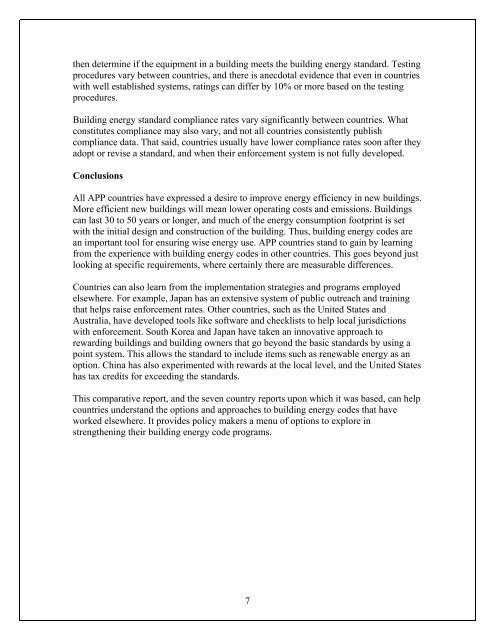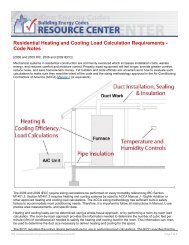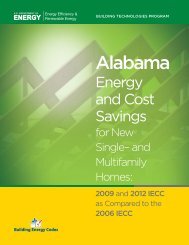efficient air condition<strong>in</strong>g system, for example, if <strong>the</strong> total designed energy use fallswith<strong>in</strong> <strong>the</strong> required norms. There are several approaches to establish<strong>in</strong>g <strong>the</strong> basel<strong>in</strong>e forcomparison under <strong>the</strong> build<strong>in</strong>g energy performance method. The United States uses costas its reference metric, while some o<strong>the</strong>r countries base <strong>the</strong> reference metric on energyconsumption.South Korea and Japan take a different approach, establish<strong>in</strong>g both mandatoryrequirements and a po<strong>in</strong>t system for a whole range of energy issues related to build<strong>in</strong>gs.Each new build<strong>in</strong>g must have a m<strong>in</strong>imum number of po<strong>in</strong>ts ei<strong>the</strong>r <strong>in</strong> total or by category.Build<strong>in</strong>gs that exceed <strong>the</strong> m<strong>in</strong>imum po<strong>in</strong>t requirement may be eligible for certa<strong>in</strong> benefits,such as relaxation of some zon<strong>in</strong>g rules.Enforcement SystemsEnforcement is critical for <strong>the</strong> standard to have an effect. Not all countries havemandatory build<strong>in</strong>g energy standards. India, for example, has a voluntary code. Japan’sstandards are also technically voluntary, although Japan has recently adopted penaltiesfor non-compliance that blur this dist<strong>in</strong>ction. The United States, Canada and Australia alladopt build<strong>in</strong>g standards at <strong>the</strong> local level. Not all jurisdictions <strong>in</strong> <strong>the</strong> United States andCanada have adopted <strong>the</strong>ir nation’s model build<strong>in</strong>g energy codes. Ch<strong>in</strong>a has mandatorynational codes, but prov<strong>in</strong>ces have <strong>the</strong> option to adopt more str<strong>in</strong>gent local codes.Some important issues regard<strong>in</strong>g enforcement and <strong>the</strong> related impact of <strong>the</strong> code onenergy use <strong>in</strong>clude: <strong>the</strong> po<strong>in</strong>t of compliance (design and/or construction stage), howbuild<strong>in</strong>gs are reviewed or <strong>in</strong>spected and by whom, penalties and o<strong>the</strong>r <strong>in</strong>centives forcompliance, tra<strong>in</strong><strong>in</strong>g and <strong>in</strong>formation on <strong>the</strong> code, compliance tools such as codecompliance software and <strong>in</strong>spection checklists, and equipment and material test<strong>in</strong>g andrat<strong>in</strong>gs.In <strong>the</strong> United States, Canada, Australia and South Korea, for example, <strong>the</strong> build<strong>in</strong>gdesign must be approved, and <strong>in</strong>spectors check <strong>the</strong> build<strong>in</strong>g for compliance at least oncedur<strong>in</strong>g construction. In Japan, <strong>the</strong> reviews only occur at <strong>the</strong> build<strong>in</strong>g design stage. Ch<strong>in</strong>auses a comb<strong>in</strong>ation of government employees and certified companies to check build<strong>in</strong>gdesigns and <strong>in</strong>spect <strong>the</strong> build<strong>in</strong>gs for compliance. There is no s<strong>in</strong>gle answer as to whichsystem produces <strong>the</strong> highest level of compliance. For example, Japanese officials believethat Japan atta<strong>in</strong>s a high level of compliance <strong>in</strong> actual construction because Japan has avery well developed system of tra<strong>in</strong><strong>in</strong>g and <strong>in</strong>formation dissem<strong>in</strong>ation on <strong>the</strong> build<strong>in</strong>genergy standards. Anecdotal evidence <strong>in</strong> <strong>the</strong> United States and o<strong>the</strong>r countries <strong>in</strong>dicatesthat <strong>in</strong>spections do play an important role <strong>in</strong> atta<strong>in</strong><strong>in</strong>g high levels of compliance. The U.S.Department of <strong>Energy</strong> is now develop<strong>in</strong>g methodologies to measure and trackcompliance.The str<strong>in</strong>gency of <strong>the</strong> national system for test<strong>in</strong>g materials and equipment for <strong>the</strong>ir energyefficiency properties can also have a marked impact on <strong>the</strong> f<strong>in</strong>al energy consumption of abuild<strong>in</strong>g. Most countries have a system of certified laboratories that test materials andequipment (like w<strong>in</strong>dows and air conditioners) and rate <strong>the</strong>m for efficiency. These rat<strong>in</strong>gs6
<strong>the</strong>n determ<strong>in</strong>e if <strong>the</strong> equipment <strong>in</strong> a build<strong>in</strong>g meets <strong>the</strong> build<strong>in</strong>g energy standard. Test<strong>in</strong>gprocedures vary between countries, and <strong>the</strong>re is anecdotal evidence that even <strong>in</strong> countrieswith well established systems, rat<strong>in</strong>gs can differ by 10% or more based on <strong>the</strong> test<strong>in</strong>gprocedures.Build<strong>in</strong>g energy standard compliance rates vary significantly between countries. Whatconstitutes compliance may also vary, and not all countries consistently publishcompliance data. That said, countries usually have lower compliance rates soon after <strong>the</strong>yadopt or revise a standard, and when <strong>the</strong>ir enforcement system is not fully developed.ConclusionsAll APP countries have expressed a desire to improve energy efficiency <strong>in</strong> new build<strong>in</strong>gs.More efficient new build<strong>in</strong>gs will mean lower operat<strong>in</strong>g costs and emissions. Build<strong>in</strong>gscan last 30 to 50 years or longer, and much of <strong>the</strong> energy consumption footpr<strong>in</strong>t is setwith <strong>the</strong> <strong>in</strong>itial design and construction of <strong>the</strong> build<strong>in</strong>g. Thus, build<strong>in</strong>g energy codes arean important tool for ensur<strong>in</strong>g wise energy use. APP countries stand to ga<strong>in</strong> by learn<strong>in</strong>gfrom <strong>the</strong> experience with build<strong>in</strong>g energy codes <strong>in</strong> o<strong>the</strong>r countries. This goes beyond justlook<strong>in</strong>g at specific requirements, where certa<strong>in</strong>ly <strong>the</strong>re are measurable differences.Countries can also learn from <strong>the</strong> implementation strategies and programs employedelsewhere. For example, Japan has an extensive system of public outreach and tra<strong>in</strong><strong>in</strong>gthat helps raise enforcement rates. O<strong>the</strong>r countries, such as <strong>the</strong> United States andAustralia, have developed tools like software and checklists to help local jurisdictionswith enforcement. South Korea and Japan have taken an <strong>in</strong>novative approach toreward<strong>in</strong>g build<strong>in</strong>gs and build<strong>in</strong>g owners that go beyond <strong>the</strong> basic standards by us<strong>in</strong>g apo<strong>in</strong>t system. This allows <strong>the</strong> standard to <strong>in</strong>clude items such as renewable energy as anoption. Ch<strong>in</strong>a has also experimented with rewards at <strong>the</strong> local level, and <strong>the</strong> United Stateshas tax credits for exceed<strong>in</strong>g <strong>the</strong> standards.This comparative report, and <strong>the</strong> seven country reports upon which it was based, can helpcountries understand <strong>the</strong> options and approaches to build<strong>in</strong>g energy codes that haveworked elsewhere. It provides policy makers a menu of options to explore <strong>in</strong>streng<strong>the</strong>n<strong>in</strong>g <strong>the</strong>ir build<strong>in</strong>g energy code programs.7
- Page 1 and 2: PNNL-122267Shaping the Energy Effic
- Page 3: Shaping the Energy Efficiency in Ne
- Page 8 and 9: ContentsForeword ..................
- Page 10 and 11: List of TablesTable 1 GDP, Primary
- Page 12 and 13: ForewordBuildings account for about
- Page 14 and 15: 1 Introduction and Background1.1 Im
- Page 16 and 17: esidential buildings in 2006, with
- Page 18 and 19: JAP 1. Criteria for Clients on the
- Page 20 and 21: can significantly increase energy d
- Page 22 and 23: f) South Korea’s building energy
- Page 24 and 25: 2.1 AustraliaIn the past, Australia
- Page 26 and 27: small cities will be pilot of such
- Page 28 and 29: (DCGREUH) issued by the Ministry of
- Page 30 and 31: according to the current codes. Thi
- Page 32 and 33: Table 7 Structural Comparison of Bu
- Page 34 and 35: 3.3 Building EnvelopeKey Findings A
- Page 36 and 37: JAPCCREUH1999KORBDCES2008USAASHRAE9
- Page 38 and 39: This study selects the midpoint sco
- Page 40 and 41: MiamiUSA0.36(Insulationabove deck)t
- Page 42 and 43: Six countries have jurisdictions in
- Page 44 and 45: thermal requirements for roofs, flo
- Page 46 and 47: Figure 6 Maximum U-factors in Resid
- Page 48 and 49: Table 16 HVAC in Japan’s Building
- Page 50 and 51: ItemsService water heating refers t
- Page 52 and 53: Water conservation Canada has manda
- Page 54 and 55: practice (MNECB 1997). India sets m
- Page 56 and 57:
Canada and India adopt compliance p
- Page 58 and 59:
Japan only supervises the building
- Page 60 and 61:
4.2 Testing and RatingKey Findings
- Page 62 and 63:
Other commonly used tools among APP
- Page 64 and 65:
CAN 55MNECH1997CHNINDECBCJAPCanadia
- Page 66 and 67:
and local jurisdiction contact info
- Page 68 and 69:
certifying third-party verifiers or
- Page 70 and 71:
Point of ControlIncentives for Comp
- Page 72 and 73:
Point of ControlIncentives for Comp
- Page 74 and 75:
AUS,continuedCANTesting Agencies an
- Page 76 and 77:
CAN,continuedCHNTesting Agencies an
- Page 78 and 79:
Testing Agencies and Certification
- Page 80 and 81:
USA,continuedTesting Agencies and C
- Page 82 and 83:
Appendix C - Compliance SoftwareAUS
- Page 84 and 85:
CANMNECB1997,continuedSoftwareMetho
- Page 86 and 87:
USAIECC 2006,continuedSoftwareMetho
- Page 88 and 89:
AUSBCA 2007,continuedCANMNECB1997CA
- Page 90 and 91:
JAP,ContinuedKORUSAASHRAE90.1-2007T
- Page 92 and 93:
AcronymsAPPAS/NZSASHRAEAUSBATFBCABD
- Page 94 and 95:
ReferencesABCB (Australian Building
- Page 96 and 97:
IEA (International Energy Agency).
- Page 98:
OEE. 2008. Energy Use Data Handbook
















